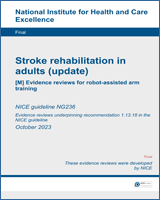From: Evidence reviews for robot-assisted arm training

NCBI Bookshelf. A service of the National Library of Medicine, National Institutes of Health.
| Study | Applicability | Limitations | Other comments | Incremental cost | Incremental effects | Cost effectiveness | Uncertainty |
|---|---|---|---|---|---|---|---|
|
Fernandez-Garcia 202131 (UK) | Directly applicable | Minor limitations(a) |
|
2-1: £1601(b) 3-1: £741(b) 3-2: Saves −£936(b) |
2-1: 0.00 QALYs 3-1: 0.01 QALYs 3-2: 0.02 QALYs |
2-1: More intensive rehabilitation (robot arm training) was dominated by usual care. 3-1 (More intensive (EULT) vs usual care): £74,100 per QALY gained 3-2: EULT dominated Robot (lower costs and higher QALYs) |
Probability cost effective (£20K threshold):
Extrapolation of data to 12-month time horizon made more intensive rehabilitation (EULT) cost effective compared to usual care (£6,095; probability cost effective 55%). More intensive (robot) remained dominated by usual care. |
| Remy-Neris 202149 | Partially applicable(c) | Potentially serious limitations(d) |
| 2−1: Saves £99(e) | 2−1(f): 0.01 QALYs | Results suggested that the Exo group intervention dominates usual care (lower costs and higher QALYs), however total costs and QALY gains were not statistically significant between groups. |
Probability of cost effective (£20K/£30K threshold): NR Results were robust to probabilistic sensitivity analysis, where uncertainty on the ICER was described using 1000 bootstrap replications on the cost-effectiveness plane. |
Abbreviations: 95% CI= 95% confidence interval; EQ-5D-3L= EuroQol 5 dimensions 3 levels (scale: 0.0 [death] to 1.0 [full health], negative values mean worse than death); FIM= functional independence measure (scale 0-18, higher values are better); FMA UE= Fugl-Meyer Assessment Upper Extremity (scale 0-66, higher scores are better); ICER= incremental cost-effectiveness ratio; NA= not applicable; NR= not reported; QALYs= quality-adjusted life years; RCT= randomised controlled trial; SIS hand function= stroke Impact Scale - hand function domain (scale 0-100, higher values are better).
Within-trial analysis based on RATULS RCT and so only reflects this study and not the wider evidence base identified in the clinical review.
2018 UK pounds. Cost components incorporated: intervention costs, follow-up costs, primary care, therapy and community-based, services, secondary care, residential and nursing home care, social services, medication costs. Unit costs were taken from 2017/18 NHS reference costs and 2017 PSSRU unit costs (which were inflated to 2018 prices using the Bank of England inflator7)
French healthcare system may not reflect current UK NHS context. EQ-5D-3L French tariff was used to estimate QALYs but NICE reference case specifies that the UK tariff is preferred.
Within-trial analysis based on a single-blinded RCT, therefore results only reflect this study and not the wider evidence base identified in the clinical review. References for unit costs were not reported which limits interpretation of results for UK context. Probability that intervention was cost-effective at £20K threshold was not reported.
2018 euros (€) converted to UK pounds purchasing power parities.81 References for unit costs were not reported but 2018 was assumed based on the study completion date. No significant between-group differences were reported for total costs (p=0.99). Cost components incorporated: Armeo®Spring exoskeleton (device cost, 5-year linear depreciation, maintenance, and physical therapist for patient training). Resource use estimates included inpatient rehabilitation days, outpatient physiotherapy, GP and specialist consultations and transportation costs.
Mean difference taken from Figure 4 of guideline clinical review. There were no significant between-group differences in changes for any of the reported outcomes at any time point (p>0.05).
From: Evidence reviews for robot-assisted arm training

NCBI Bookshelf. A service of the National Library of Medicine, National Institutes of Health.